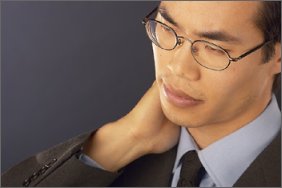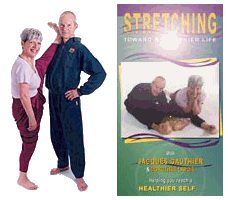Physical Pain: 8 Non-Drug Tactics to Eliminate Back, Joint & Other Pain
by SixWise.com
For the majority of Americans, pain -- either chronic or the kind that
comes and goes -- is a way of life. More than half of us suffer from physical
pain, which means that if you were to stop someone randomly on the street
and ask "Are you in pain?" chances are high that they'd say
yes.
This finding comes from a nationwide phone survey of over 1,200 Americans,
sponsored by Stanford University Medical Center, ABC News and USA Today.
Back pain was the most common type of pain reported, followed by knee
and shoulder pain, joint pain and headaches.
|

The majority of Americans feel chronic or intermittent pain. Have
we begun to accept life with pain as inevitable?
|
When pain strikes, about 80 percent of Americans reach for over-the-counter
drugs or home remedies to help. 60 percent have also tried other pain-relief
methods including prescription drugs, bed rest and prayer. More than 10
percent of adults now rely on prescription painkillers everyday (interestingly,
the survey reported that prayer and prescription drugs worked best, and
equally well, in addressing Americans' pain).
And the pain is more than just a mere nuisance, as it can severely impact
people's work, relationships, mood and more.
"Pain has been a hidden disease; it has not received as much attention
as other diseases. But now there's a growing recognition that pain really
is not just the sensation we have--it's something that interferes with
every one of us, with life," said Raymond Gaeta, M.D., associate
professor of anesthesia at the Stanford School of Medicine and director
of pain management services at Stanford Hospital & Clinics.
A separate phone survey of 800 adults, the Americans Living with Pain
Survey (ALPS), found similar results. Two out of three respondents said
that their pain led to stress and irritability, while:
- 45 percent said pain negatively impacted their personal relationships
- 51 percent said it affected their work productivity
- 61 percent said it affected their daily routine
"This survey demonstrates that chronic pain is a problem that has
reached near epidemic proportions," said Edward Covington, M.D.,
director of the Chronic Pain Rehabilitation Program at the Cleveland Clinic.
"The 'can do, can cope' spirit of Americans can lead to untreated
chronic pain, which has a severe impact on people's work, personal relationships,
hobbies, and even sex, and can greatly diminish their quality of life.
In addition to physical disability, it may also lead to irritability,
anxiety, or depression."
To look at the glass half-full, pain can be construed as a good thing.
It serves as a warning of a deeper, underlying problem, which otherwise
may have gone unnoticed. So it's extremely important not to simply ignore
or mask your pain, but rather to seek out and address the problem that's
causing you to be in pain. Once that problem has been addressed, it's
likely the pain will subside. In the event that it doesn't, here are eight
methods you can try to reduce and eliminate pain, without relying on prescription
or over-the-counter drugs.
1. Deep and Proper Sleeping/Relaxation
Says Dr. Neil B. Kavey, director of the Sleep Disorders Center at Columbia-Presbyterian
Medical Center in New York City, sleep is the time when your body is able
to do repair work. So whether you're in pain from an injury or due to
an underlying condition, your body will be able to fight and work toward
healing that pain while you sleep.
Pain and sleep is a bit of a catch-22 though, in that often people with
pain have trouble falling asleep. If this sounds familiar to you, you
may want to try the Sleep
Easy CD. With guided sleep meditations by a leading meditation expert,
Mary Maddux, and music by a renowned meditation music composer, this CD
will help you find the deep rest and sleep your body needs.
Relaxation is also important, not only in helping you to fall asleep,
but by reducing tension in your muscles, which can help to relieve pain
or keep it from getting worse. Being relaxed may also help any other pain
relief methods you're using to work better. To help you relax, the Pure
Relaxation CD -- also produced by meditation expert Mary Maddux --
helps you to give your body "permission" to relax, and will
calm your mind, soothe your emotions and create a state of deep relaxation
in your body. (If you are interested, both the Sleep CD and Pure Relaxation
CD have limited time free shipping right now.)
2. Prayer/Meditation
Similar to relaxation, meditation and prayer are ways to calm your body,
focus your mind and reduce stress, all of which can help to lessen your
feelings of pain. Prayer is the most commonly practiced type of meditation,
and according to the first study it ranked right up there with prescription
drugs for its ability to relieve pain - obviously without any of the possible
negative side effects of drugs!
"Prayer falls in the category of having patients learn about the
meaning of their pain. Sometimes patients do need to be introspective
before they can move forward," said Gaeta.
Meditation includes concentration meditations, in which you focus your
mind on a single object, phrase or thought and often practice deep breathing
as well, and exercise meditations like yoga, tai chi and qi gong. Even
reading, thinking about those you love and writing can be forms of meditation.
Pick the method that feels most naturally alluring to you.
|

Stretching regularly is an excellent way to relieve physical pain.
|
3. Stretching
After three weeks of stretching, stretching expert Jacques Gauthier was
able to reduce his pain by 50 percent. Stretching helps to reduce tension
in your muscles, improve flexibility and range of motion, and may slow
the degeneration of your joints. The act of stretching alone will also
improve your blood circulation and help you to relax--a key to pain relief.
To learn how to do the right type of stretching--the kind that actually
feel good while you do them (and after!)--we highly recommend the Stretching
Toward a Healthier Life DVD.
Gauthier and his wife Dorothee Lavoie present 15 stretches that stretch
all the key muscles groups throughout your entire body, and it only takes
about 15-20 minutes per day total to do the complete stretching routine.
Anyone who's suffering from pain should make stretching a priority.
4. Reduce/Prevent Inflammation
When your body is in a chronic state of inflammation, the inflammation
can lodge in your muscles, joints and tissues. Over time, this can lead
to physical pain, as well as a number of diseases including heart disease.
Emotions (too much stress), diet and lifestyle all contribute to inflammation.
One of the safest, low-risk things you can do to lower your risk of inflammation
is to modify your lifestyle and dietary choices. This means eating a variety
of anti-inflammatory foods (fruits and vegetables), limiting or avoiding
all together the pro-inflammatory foods (highly processed foods, high-sugar
foods, trans fats, etc.), exercising and quitting smoking (if you do).
Unfortunately, the conventional methods to treat inflammation are high
in risk. These would include medications like COX-2 inhibitors (Vioxx,
Bextra, Celebrex, etc.), which have been highlighted in the media lately
because of their link to heart problems. If you're looking for a safe
alternative to COX-2 inhibitors, we highly recommend Garden
of Life's For Your Inflammation (FYI) formula. It's a synergistically
balanced whole food, herbal and enzyme blend that is clinically proven
to reduce the effects of inflammation. It was formulated to provide the
body with the building blocks needed to rebuild and support healthy cartilage
and connective tissue, as well as to control and prevent inflammation
throughout the body.
5. Regular Exercise
"One of the most important aspects of managing one's pain is taking
an active role in care and becoming part of the treatment team,"
says Penney Cowan, executive director of the American Chronic Pain Association.
"There are many treatment options available to help people reduce
the effects of pain in their lives. Proactive behavior such as recognizing
emotions and practicing relaxation techniques to reduce stress, pacing
activities and working within personal limits, and exercising on a regular
basis may contribute to better pain control."
Although you may be tempted to not move around much when you're facing
pain, a regular exercise program can actually help to relieve pain. According
to the Mayo clinic, exercise works by prompting your body to release chemicals
called endorphins that actually block pain signals from reaching your
brain.
"Endorphins are the body's natural pain-relieving chemicals that
in many cases are more powerful than morphine," says Edward Laskowski,
M.D., a physical medicine and rehabilitation specialist and co-director
of the Sports Medicine Center at Mayo Clinic, Rochester, Minn.
Plus, exercise will help you to sleep better, have more energy to cope
with your pain, and lose weight, which will relieve any excess strain
on your joints. If you're currently in pain, remember to consult your
physician before starting any exercise program.
|
Stretch Your Pain Away with
"Stretching Toward a Healthier Life"

If you have back pain, neck pain, or pain in your knees, shoulders,
arms, hands or other parts of your body, you are doing yourself
an extreme disservice by not stretching.
As with exercise, proper form in stretching has everything to do
with achieving the maximum health benefits (and avoiding personal
injury.) Most effective is to see--step-by-step--the proper form
of each and every stretch in action by an expert versus seeing a
single snapshot of the stretch in a book (or just reading about
each stretch.)
Stretching Toward a Healthier Life on DVD gets our top recommendation
for five key reasons:
-
It presents 15 stretches that stretch all the key muscles groups
throughout your entire body (something we did not see with several
other guides we reviewed).
-
It only takes about 15-20 minutes per day total to do the complete
stretching.
-
Stretching expert and host Jacques Gauthier and his wife Dorothee
Lavoie demonstrate each stretch in their entirety, including
insights on what NOT to do.
-
In addition to stretching nearly 100% of the muscles in your
body, Gauthier chose 15 stretches that you'll find actually
feel good and are easy to do (many stretches in other programs
are not).
-
The production quality of the video and sound is excellent.
(Many other DVD productions on stretching are not.)
Find
out more about Stretching
Toward a Healthier Life with
FREE SHIPPING for a Limited Time!
|
6. Chiropractic
According to the American Chiropractic Association:
Chiropractic is a branch of the healing arts which is concerned with
human health and disease processes. Doctors of Chiropractic are physicians
who consider man as an integrated being and give special attention to
the physiological and biochemical aspects including structural, spinal,
musculoskeletal, neurological, vascular, nutritional, emotional and
environmental relationships.
Every Doctor of Chiropractic is different, and will use varying chiropractic
methods to relieve your pain. According to the first survey above, chiropractic
(and massage therapy) ranked second-best at relieving pain. If you're
interested, the American Chiropractic Association has an online tool to
help you find a Doctor of Chiropractic near you http://www.amerchiro.org/search/memsearch.cfm.
7. Massage Therapy
The American Massage Therapy Association (AMTA) says massage therapy:
-
Helps patients become more aware of their bodies and the sources
of pain.
-
Better familiarizes patients with the pain they experience.
-
Has an impact on the patient by virtue of human touch.
-
Improves confidence by encouraging patients to effectively cope
with their pain.
Further, according to an American Hospital Association survey about their
use of CAM (complementary and alternative medicine) therapies, nearly
82 percent of the hospitals offering CAM therapies offered massage therapy.
More than 70 percent of these used the massage therapy for the purpose
of pain management and relief.
The AMTA can help you to find
a massage therapist near you.
8. Hot or Cold Packs
Applying a hot pad or cold pack to your area of pain can provide temporary
relief. Hot pads are helpful for sore muscles, while cold packs work by
numbing the affected area. If you've only tried one or the other, switch
to the opposite and see if it works. Be careful not to use a pad that
is too hot or too cold, and when using a cold pack, wrap it in a towel
so you don't expose your skin to the cold.
Recommended Reading
How
One Boring Revolution has EVERYTHING to Do With Your Health
The
Top Six Stressor Areas in Life: How to Recognize & Handle the Stress
Sources
HealthOrbit
May 9, 2005
Medical
News Today May 9, 2005
The
Mayo Clinic
American
Massage Therapy Association